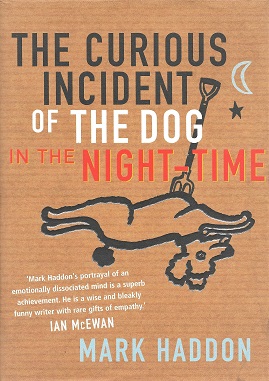The Curious Incident of the Dog in the Night-Time
The Curious Incident of the Dog in the Night-Time is a mystery novel written by British author Mark Haddon. First published in 2003, the book tells the story of Christopher John Francis Boone, a 15-year-old boy who describes himself as "a mathematician with some behavioral difficulties" living in Swindon, Wiltshire. Although Christopher's exact diagnosis is not stated, the book's portrayal of his aversion to being touched, difficulty with social interactions, and exceptional abilities in mathematics suggests he is on the autism spectrum.
Plot[edit | edit source]
The novel begins with Christopher discovering the dead body of Wellington, a neighbour's dog, speared with a garden fork. Despite being initially suspected of the crime, Christopher is determined to solve the mystery, emulating his hero, the fictional detective Sherlock Holmes. His investigation leads him on a journey that upturns his world, uncovering family secrets and testing his abilities to navigate the complexities of the world around him.
Themes[edit | edit source]
The Curious Incident of the Dog in the Night-Time explores several themes, including the challenges of living with autism, the nature of truth and lies, and the complexity of human relationships. Christopher's perspective provides a fresh insight into everyday life, highlighting how ordinary situations can be perceived differently by individuals with autism.
Reception[edit | edit source]
The novel received critical acclaim for its unique narrative voice and its sensitive, yet humorous portrayal of Christopher. It has won several awards, including the 2003 Whitbread Book of the Year and the 2004 Commonwealth Writers' Prize for Best First Book. Its success has led to its adaptation into a highly successful stage play, which premiered in London in 2012.
Adaptations[edit | edit source]
The stage adaptation of The Curious Incident of the Dog in the Night-Time was adapted by playwright Simon Stephens and produced by the National Theatre. It has been praised for its innovative use of stage design and effects to convey Christopher's sensory experience and thought processes. The play has won numerous awards, including the 2013 Laurence Olivier Award for Best New Play and the 2015 Tony Award for Best Play.
Impact[edit | edit source]
The novel has been used in educational settings to promote understanding of autism and has sparked discussions about the representation of autistic individuals in literature and media. It has also been noted for its unique narrative style, which challenges traditional storytelling methods.
See Also[edit | edit source]
- Autism spectrum
- Mystery novel
- Sherlock Holmes
- Whitbread Book Awards
- Commonwealth Writers' Prize
- National Theatre
- Laurence Olivier Award
- Tony Award
This article is a literature-related stub. You can help WikiMD by expanding it!
Search WikiMD
Ad.Tired of being Overweight? Try W8MD's physician weight loss program.
Semaglutide (Ozempic / Wegovy and Tirzepatide (Mounjaro / Zepbound) available.
Advertise on WikiMD
|
WikiMD's Wellness Encyclopedia |
| Let Food Be Thy Medicine Medicine Thy Food - Hippocrates |
Translate this page: - East Asian
中文,
日本,
한국어,
South Asian
हिन्दी,
தமிழ்,
తెలుగు,
Urdu,
ಕನ್ನಡ,
Southeast Asian
Indonesian,
Vietnamese,
Thai,
မြန်မာဘာသာ,
বাংলা
European
español,
Deutsch,
français,
Greek,
português do Brasil,
polski,
română,
русский,
Nederlands,
norsk,
svenska,
suomi,
Italian
Middle Eastern & African
عربى,
Turkish,
Persian,
Hebrew,
Afrikaans,
isiZulu,
Kiswahili,
Other
Bulgarian,
Hungarian,
Czech,
Swedish,
മലയാളം,
मराठी,
ਪੰਜਾਬੀ,
ગુજરાતી,
Portuguese,
Ukrainian
Medical Disclaimer: WikiMD is not a substitute for professional medical advice. The information on WikiMD is provided as an information resource only, may be incorrect, outdated or misleading, and is not to be used or relied on for any diagnostic or treatment purposes. Please consult your health care provider before making any healthcare decisions or for guidance about a specific medical condition. WikiMD expressly disclaims responsibility, and shall have no liability, for any damages, loss, injury, or liability whatsoever suffered as a result of your reliance on the information contained in this site. By visiting this site you agree to the foregoing terms and conditions, which may from time to time be changed or supplemented by WikiMD. If you do not agree to the foregoing terms and conditions, you should not enter or use this site. See full disclaimer.
Credits:Most images are courtesy of Wikimedia commons, and templates, categories Wikipedia, licensed under CC BY SA or similar.
Contributors: Prab R. Tumpati, MD

